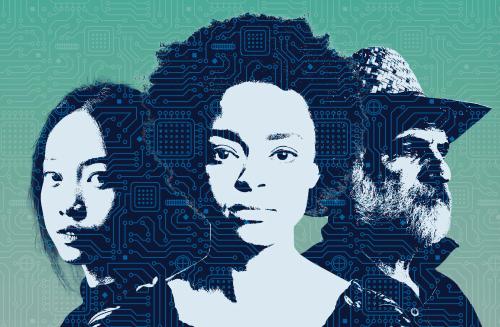For many young people, the path from the K-12 educational system to a good job as an adult is an obstacle course. High school is the last universally available educational option, and when young people leave or graduate, the next steps are not always obvious.
While education beyond high school is the surest ticket to the middle class, the postsecondary landscape is complicated and hard to navigate. For those whose families and schools can’t provide adequate guidance, it is not easy to identify college and training options that are affordable and a good fit. For those who do not enroll in college—as well as for the many who do enroll but don’t complete a degree or certification—employment prospects are largely limited to low-wage jobs. And, with a few exceptions, neither secondary nor postsecondary systems have a clear interface with the world of work. Among students and employers, there are few shared benchmarks outlining the skill requirements for different industries and occupations, how to obtain those skills, and how to measure them. As a result, young people have high levels of unemployment and tend to cycle in and out of jobs even as employers report difficulty finding workers with the necessary skills and experience.
Moreover, the educational and employment landscapes are riddled with inequities that routinely disadvantage young people who are Black, Latino or Hispanic, or low-income. The K-12 and postsecondary education systems are deeply stratified by race and class, and do not live up to the essential American goal of providing equal opportunity. When looking for work, young people who are poorly served by the educational system are plunged into a similarly stratified labor market, in which educational attainment and race are key markers.
The COVID-19 pandemic has only amplified these existing inequalities. But these outcomes are not inevitable—they are the result of policy choices. And better policy choices can change them.
In this report, we envision high-quality work-based learning (WBL) as a lever to advance equity and economic opportunity for young people. Through WBL experiences such as internships and apprenticeships, young people can learn the technical, academic, and interpersonal skills they need to function in a workplace—an environment they will enter in just a few years and where they will spend decades of their lives. This expansive vision of WBL would emphasize supportive relationships with adults, connections to broader social and professional networks, and authentic work experiences that provide hands-on learning opportunities and the chance to take on new roles and responsibilities.
Based on interviews and analyses of the relevant literature, we synthesize lessons from research and practice in education, youth development, and workforce development to weave together a vision of high-quality work-based learning. We identify three critical elements and explore the implications for WBL programs, particularly those serving high school students and out-of-school youth (young people who are not in school and have less than a college degree).
- Positive relationships with adults that support growth and development. Supportive relationships with adults (teachers, youth counselors, supervisors, coaches, etc.) are critical for healthy development. They offer young people the opportunity to learn self-regulating behavior, develop social skills, and build resiliency. Relationships with adults that are grounded in safety, trust, and respect are a key ingredient in programs for youth—as important or more important than any particular curriculum or program element. It takes deliberate effort to foster such relationships, but funding streams, program design, and performance incentives often create obstacles to them.
- Social capital that provides information and contacts regarding employment. Social capital is described most succinctly by the saying, “It’s not what you know; it’s who you know.” In a WBL context, adult supervisors, mentors, instructors, and others can provide youth with access to valuable resources such as information, assistance, exposure to adult worlds, support, and encouragement. This is especially important to those unlikely to receive such assistance through their personal and family networks. In turn, these connections can open new channels for organizations to find job candidates and, ideally, provide young people an inroad to the informal referral process that is so common in recruitment and hiring. While most employment and WBL programs recognize the value of social capital, they usually emphasize skills and credentials. Connecting young adults to a diverse array of people who can help them find resources and job opportunities is typically less of a priority.
- Work experiences that offer opportunities for hands-on learning and expose young people to new environments and expectations. The basic ingredients for a successful work-based learning experience are clear job tasks and expectations, some level of responsibility, access to applied learning in a specific industry context, and feedback from supervisors and peers. When done well, WBL provides young people with meaningful exposure to workers, job duties, and workplaces, and offers opportunities to learn occupational and employability skills in ways that are difficult to achieve in the classroom alone.
The popularity of work-based learning has surged in recent years, with new energy and activity at the state and local levels. Even so, it is uneven in its availability and quality across the country, and still plays a niche role in education and workforce development. Unless we substantially increase our commitment to high-quality WBL, it will continue to reach a relatively small number of young people, relatively few programs will be designed, staffed, and funded to incorporate best practices, and probably even fewer programs will have the resources to focus on quality improvement and evaluation.
States have an important role to play in supporting high-quality WBL at the local level. In this report, we highlight four state policy strategies to expand the availability of relationship-rich work-based opportunities: developing a clear vision, definitions, and goals; identifying and tracking program quality metrics; supporting implementation with adequate funding and professional development; and coordinating across state agencies and local programs.
Of course, the COVID-19 pandemic has thrown the economy and educational system into turmoil. Educators in the midst of a rapid pivot to remote learning understandably have limited capacity to focus on enhancing or expanding work-based learning. At the same time, however, the dramatic rise in unemployment and the disruptions to education will hit young adults particularly hard and aggravate racial and ethnic inequities, making it even more imperative to build stronger, more robust connections to careers for young people. We need to reimagine the school-to-work transition so that it does not systematically leave millions of young adults behind.
As we recover from this health and economic crisis, schools, workforce development programs, mayors, governors, business associations, and employers should develop and expand high-quality, relationship-rich work-based learning options as a pathway to greater economic opportunity.
The Brookings Institution is committed to quality, independence, and impact.
We are supported by a diverse array of funders. In line with our values and policies, each Brookings publication represents the sole views of its author(s).










